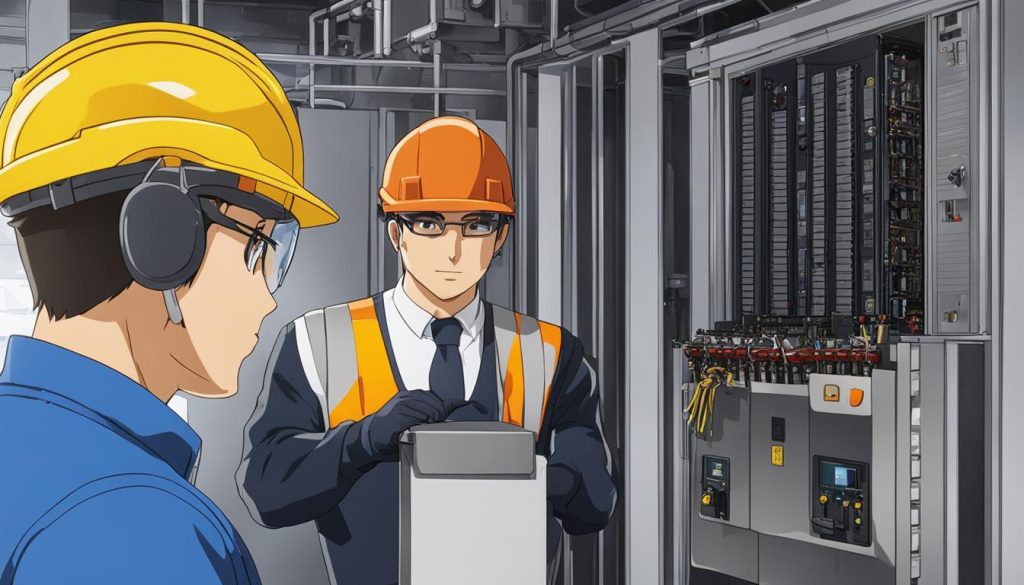Essential Guide to Electricity at Work Regs 1989
The Electricity at Work Regulations 1989 is a set of health and safety regulations that provide guidelines for the safe use of electrical equipment in the workplace. These regulations are an essential aspect of ensuring workplace safety and compliance with health and safety guidelines in the UK.
Electrical safety is of utmost importance, and failure to comply with these regulations can lead to serious repercussions, including workplace injuries, damage to property and even fatalities. Therefore, it is crucial that businesses and individuals understand and adhere to these regulations to maintain workplace safety and reduce the risk of electrical hazards.
This section aims to provide an overview of the Electricity at Work Regulations 1989, the key aspects, and requirements of the regulations. It will also highlight the importance of electrical safety guidelines and standards in the workplace.
Key Takeaways
- Electricity at Work Regulations 1989 provides guidelines for electrical safety in the workplace.
- Adhering to these regulations reduces the risk of electrical hazards, workplace injuries, and fatalities.
- Electrical safety guidelines and standards must be followed to ensure compliance with the regulations.
- Regular inspections and maintenance of electrical equipment are essential in maintaining workplace safety.
- Proper installation and use of electrical equipment mitigate potential hazards.
Understanding Electrical Safety Regulations UK
When it comes to electricity in the workplace, safety is paramount. In the UK, electrical workplaces are governed by a set of regulations known as the Electrical Safety Regulations UK. These regulations aim to ensure workplace electrical safety and minimise the risk of electrical hazard.
Employers have a duty of care to their employees under the Health and Safety at Work Act (1974) and the Electricity at Work Regulations 1989. This means they must take all necessary precautions to prevent electrical hazards and manage electrical risks. Compliance with the electrical safety regulations in the UK is not only important to avoid accidents but also to avoid prosecution and fines.
Prevention of electrical hazards starts with proper risk management. Employers must identify electrical hazards, assess the risks, and put in place suitable controls to manage the risks. This includes installing safe electrical systems and equipment, preventing unauthorised access to electrical equipment, and providing adequate training and supervision to employees who work with or near electrical equipment.
Regular inspections and maintenance of electrical equipment are also crucial to maintaining workplace electrical safety. Employers must have a robust system in place to ensure that electrical equipment is regularly tested and inspected by competent personnel to prevent accidents caused by faulty equipment.

The best way to ensure compliance with the electrical safety regulations in the UK is to stay informed about the latest electrical safety guidelines and standards. Employers must also ensure that their employees are aware of the electrical hazards and safety procedures in the workplace.
Ensuring Electrical Equipment Safety
In any workplace that uses electrical equipment, safety is of paramount importance. To ensure that workers are not put at risk of harm, it is essential to follow the proper standards and guidelines for electrical equipment safety. Compliance with these guidelines can help to prevent electrical hazards and protect both employees and equipment from damage.
One of the most important aspects of electrical equipment safety is adherence to electrical safety standards. These standards ensure that all equipment is properly installed and maintained to prevent hazards such as electrocution or fire. It is crucial to regularly inspect equipment to ensure that it is functioning safely and efficiently with no faults or defects.
Electrical hazard prevention is another critical element of ensuring electrical equipment safety. This involves taking steps to identify and address potential hazards before they can cause harm. For example, ensuring that all electrical equipment is grounded, using proper lockout/tagout procedures when maintenance is being performed, and replacing damaged equipment promptly.
Proper usage of electrical equipment is also essential for safety. Workers must be trained to use equipment safely and follow best practices to mitigate any potential hazards. This includes using the correct personal protective equipment, such as gloves, helmets, or goggles, when appropriate.
Overall, ensuring electrical equipment safety is crucial to maintaining a safe workplace environment. By following the appropriate electrical safety standards and guidelines, identifying and addressing potential hazards, and using equipment correctly, workers can remain safe and free from harm.
FAQ
What are the Electricity at Work Regulations 1989?
The Electricity at Work Regulations 1989 are health and safety regulations in the UK that aim to prevent electrical accidents and ensure the safety of people at work. They require employers to maintain electrical systems and equipment in a safe condition, and to take necessary precautions to prevent electrical hazards.
Why are the Electricity at Work Regulations 1989 important?
The Electricity at Work Regulations 1989 are important because they help protect workers from the risks associated with electricity. They set standards for electrical safety in the workplace, and non-compliance can result in serious injuries or fatalities. By complying with these regulations, employers can create a safer working environment and minimize the risk of electrical accidents.
What are some key requirements of the Electricity at Work Regulations 1989?
Some key requirements of the Electricity at Work Regulations 1989 include:
– Ensuring that electrical systems are constructed, maintained, and used in a safe manner.
– Conducting regular inspections and tests of electrical equipment to identify and address potential risks.
– Providing appropriate training and information to employees to ensure they can work safely with electrical equipment.
– Implementing measures to prevent the risk of electric shock, fire, and explosion.
– Keeping records of inspections, tests, and maintenance performed on electrical equipment.
– Having competent individuals responsible for the design, installation, and maintenance of electrical systems.
How can employers ensure compliance with the Electricity at Work Regulations 1989?
Employers can ensure compliance with the Electricity at Work Regulations 1989 by:
– Conducting regular risk assessments to identify electrical hazards in the workplace.
– Providing adequate training to employees on electrical safety procedures and practices.
– Ensuring that electrical equipment is properly installed, inspected, and tested.
– Keeping up-to-date records of inspections, tests, and maintenance performed on electrical equipment.
– Implementing a system for reporting and addressing electrical safety concerns and incidents.
– Seeking guidance from competent professionals, such as electricians and safety consultants, when necessary.
What are the penalties for non-compliance with the Electricity at Work Regulations 1989?
Non-compliance with the Electricity at Work Regulations 1989 can result in legal consequences for employers. The penalties can include fines and even imprisonment in cases of serious breaches that lead to severe injuries or fatalities. Additionally, non-compliance can damage a company’s reputation and result in financial losses due to legal proceedings, compensation claims, and business disruptions.
What should employees do if they have concerns about electrical safety in the workplace?
Employees who have concerns about electrical safety in the workplace should report their concerns to their supervisor or the appropriate health and safety representative. Employers are legally obligated to address and mitigate any identified risks to ensure the safety of their employees. If concerns are not adequately addressed, employees can seek guidance from regulatory bodies or trade unions to escalate their concerns and ensure compliance with the Electricity at Work Regulations 1989.




